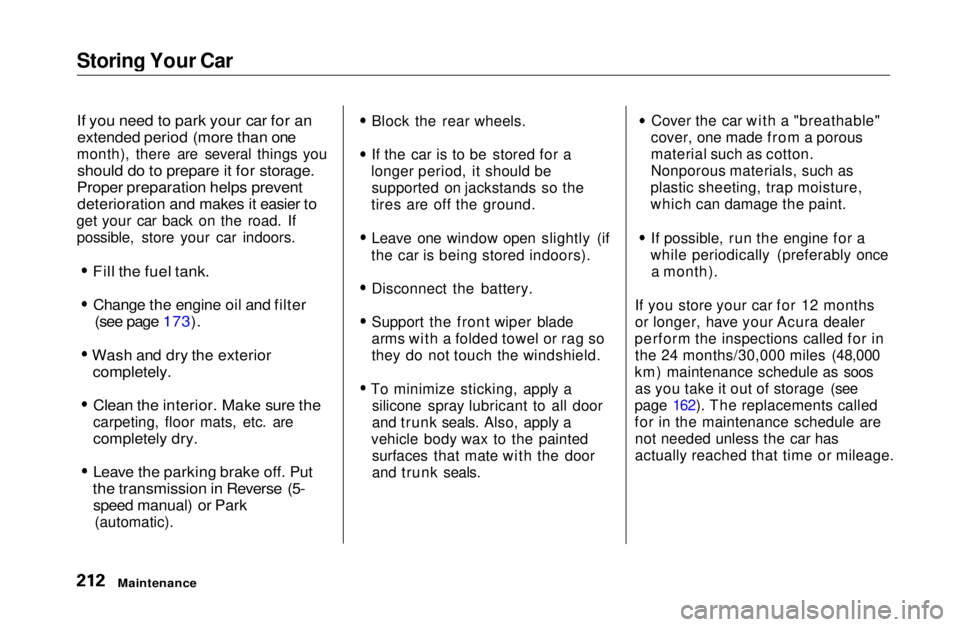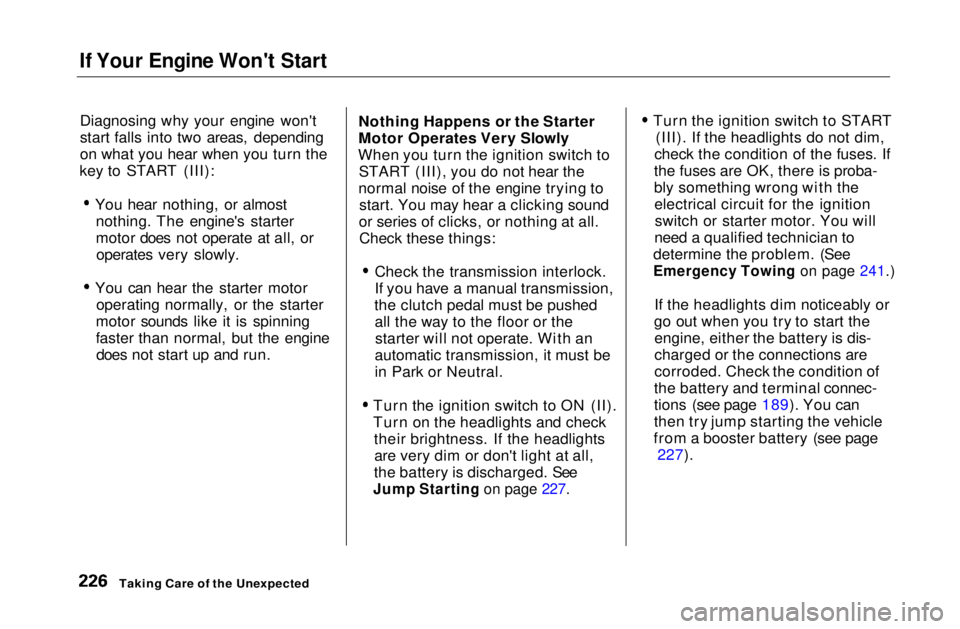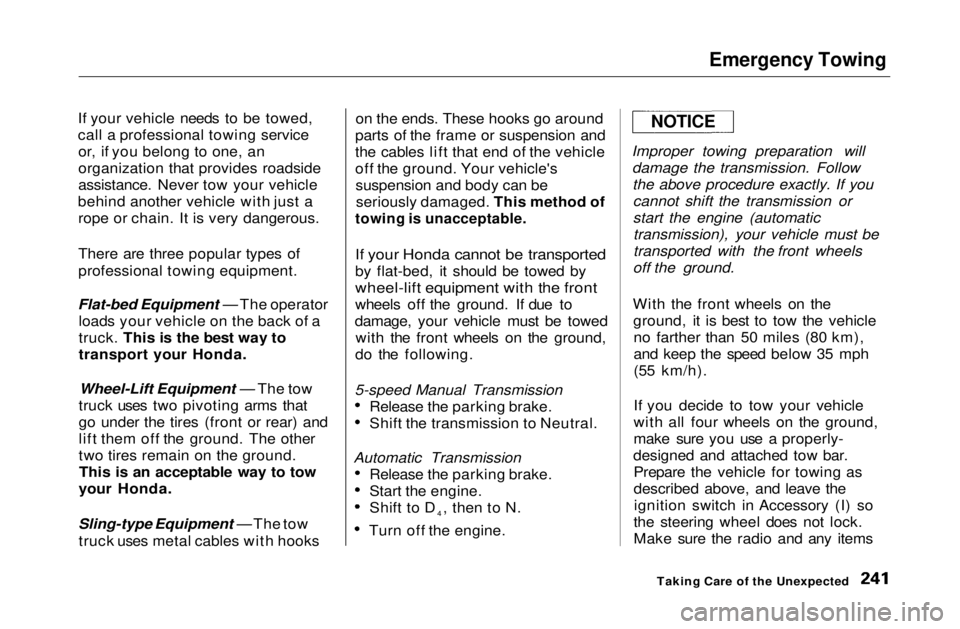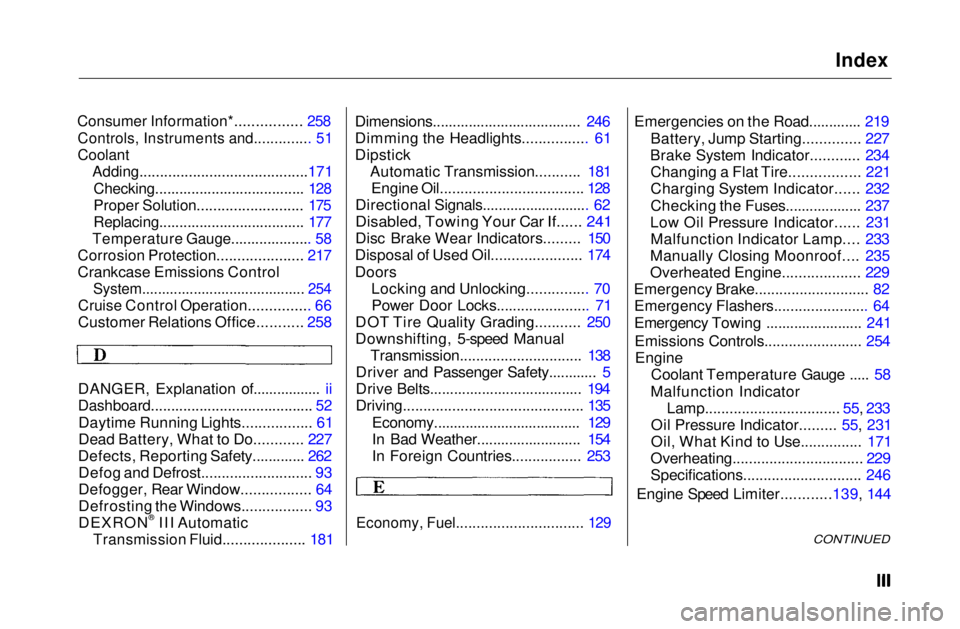1999 HONDA CIVIC COUPE manual transmission
[x] Cancel search: manual transmissionPage 181 of 269

Transmission Fluid, Brake and Clutch Fluid
5-speed Manual Transmission
FILLER BOLT
Correct level
Check the fluid level with the
transmission at normal operating
temperature and the car sitting on
level ground. Remove the
transmission filler bolt and carefully
feel inside the bolt hole with your
finger. The fluid level should be up to the edge of the bolt hole. If it is
not, add Genuine Honda Manual
Transmission Fluid (MTF) until it starts to run out of the hole. Reinstall
the filler bolt and tighten it securely. If Honda MTF is not available, you
may use an API service SG, SH or SJ
grade motor oil with a viscosity of SAE 10W-30 or 10W-40 as a
temporary replacement. An SG grade is preferred, but an SH or SJ
grade may be used if SG is notavailable. However, motor oil does
not contain the proper additives and
continued use can cause stiffer shifting. Replace as soon asconvenient.
The transmission should be drained and refilled with new fluid according
to the time and distance recommen- dations in the maintenance schedule. Brake and Clutch Fluid
Check the fluid level in the reser-
voirs monthly. There are up to two reservoirs, depending on the model.
They are:
Brake fluid reservoir (all models) Clutch fluid reservoir
(manual transmission only)
The brake fluid should be replaced according to the time and distance
recommendations in the mainte- nance schedule.
MaintenanceMain Menu Table of Contents s t
Page 211 of 269

Storing Your Car
If you need to park your car for an
extended period (more than one
month), there are several things you
should do to prepare it for storage.
Proper preparation helps prevent
deterioration and makes it easier to
get your car back on the road. If possible, store your car indoors.
Fill the fuel tank.
Change the engine oil and filter
(see page 173).
Wash and dry the exterior
completely.
Clean the interior. Make sure the
carpeting, floor mats, etc. are
completely dry.
Leave the parking brake off. Put
the transmission in Reverse (5-
speed manual) or Park
(automatic). Block the rear wheels.
If the car is to be stored for a
longer period, it should be supported on jackstands so the
tires are off the ground.
Leave one window open slightly (if
the car is being stored indoors).
Disconnect the battery.
Support the front wiper blade
arms with a folded towel or rag so
they do not touch the windshield.
To minimize sticking, apply a silicone spray lubricant to all door
and trunk seals. Also, apply a
vehicle body wax to the painted surfaces that mate with the door
and trunk seals. Cover the car with a "breathable"
cover, one made from a porous
material such as cotton.
Nonporous materials, such as
plastic sheeting, trap moisture,
which can damage the paint.
If possible, run the engine for a
while periodically (preferably once a month).
If you store your car for 12 months
or longer, have your Acura dealer
perform the inspections called for in the 24 months/30,000 miles (48,000
km) maintenance schedule as soos as you take it out of storage (see
page 162). The replacements called
for in the maintenance schedule are not needed unless the car has
actually reached that time or mileage.
MaintenanceMain Menu Table of Contents s t
Page 225 of 269

If Your Engine Won't Start
Diagnosing why your engine won't
start falls into two areas, depending
on what you hear when you turn the
key to START (III):
You hear nothing, or almostnothing. The engine's starter
motor does not operate at all, oroperates very slowly.
You can hear the starter motor operating normally, or the starter
motor sounds like it is spinning
faster than normal, but the engine does not start up and run. Nothing Happens or the Starter
Motor Operates Very Slowly
When you turn the ignition switch to START (III), you do not hear the
normal noise of the engine trying to start. You may hear a clicking sound
or series of clicks, or nothing at all. Check these things:
Check the transmission interlock.
If you have a manual transmission,
the clutch pedal must be pushed all the way to the floor or thestarter will not operate. With an
automatic transmission, it must be
in Park or Neutral.
Turn the ignition switch to ON (II).
Turn on the headlights and check their brightness. If the headlightsare very dim or don't light at all,
the battery is discharged. See
Jump Starting on page 227.
Turn the ignition switch to START
(III). If the headlights do not dim,
check the condition of the fuses. If
the fuses are OK, there is proba-
bly something wrong with the electrical circuit for the ignitionswitch or starter motor. You will
need a qualified technician to
determine the problem. (See
Emergency Towing on page 241.)
If the headlights dim noticeably or
go out when you try to start the engine, either the battery is dis-
charged or the connections are
corroded. Check the condition of
the battery and terminal connec-
tions (see page 189). You can
then try jump starting the vehicle
from a booster battery (see page 227).
Taking Care of the UnexpectedMain Menu Table of Contents s t
Page 240 of 269

Emergency Towing
If your vehicle needs to be towed,
call a professional towing service or, if you belong to one, an
organization that provides roadside
assistance. Never tow your vehicle
behind another vehicle with just a rope or chain. It is very dangerous.
There are three popular types of
professional towing equipment.
Flat-bed Equipment — The operator loads your vehicle on the back of a
truck. This is the best way to
transport your Honda.
Wheel-Lift Equipment — The tow
truck uses two pivoting arms that
go under the tires (front or rear) and
lift them off the ground. The other
two tires remain on the ground. This is an acceptable way to tow
your Honda.
Sling-type Equipment — The tow truck uses metal cables with hooks on the ends. These hooks go around
parts of the frame or suspension and
the cables lift that end of the vehicle
off the ground. Your vehicle's suspension and body can beseriously damaged. This method of
towing is unacceptable.
If your Honda cannot be transported
by flat-bed, it should be towed by
wheel-lift equipment with the front
wheels off the ground. If due to
damage, your vehicle must be towed with the front wheels on the ground,
do the following.
5-speed Manual Transmission Release the parking brake.
Shift the transmission to Neutral.
Automatic Transmission Release the parking brake.
Start the engine.
Shift to D4, then to N.
Turn off the engine. Improper towing preparation will
damage the transmission. Followthe above procedure exactly. If youcannot shift the transmission or
start the engine (automatictransmission), your vehicle must be
transported with the front wheels
off the ground.
With the front wheels on the ground, it is best to tow the vehicleno farther than 50 miles (80 km),
and keep the speed below 35 mph
(55 km/h).
If you decide to tow your vehicle
with all four wheels on the ground,
make sure you use a properly-
designed and attached tow bar. Prepare the vehicle for towing as
described above, and leave theignition switch in Accessory (I) so
the steering wheel does not lock.
Make sure the radio and any items
Taking Care of the Unexpected
NOTICEMain Menu Table of Contents s t
Page 254 of 269

Emissions Controls
Exhaust Emissions Controls
The exhaust emissions controls include three systems: PGM-FI,
Ignition Timing Control and Three
Way Catalytic Converter. These three systems work together tocontrol the engine's combustion and
minimize the amount of HC, CO, and
NOx that comes out the tailpipe. Theexhaust emissions control systems
are separate from the crankcase and
evaporative emissions control
systems.
PGM-FI System
The PGM-FI System uses sequential multiport fuel injection.
It has three subsystems: Air Intake,Engine Control, and Fuel Control.
The Engine Control Module (ECM)/ Powertrain Control Module (PCM)/
Transmission Control Module (TCM-HX model only) uses various
sensors to determine how much air
is going into the engine. It then controls how much fuel to inject under all operating conditions.
Ignition Timing Control System
This system constantly adjusts the ignition timing, reducing the amountof HC, CO and NOx produced.
Exhaust Gas Recirculation (EGR) System
Only on HX model
The Exhaust Gas Recirculation (EGR) system takes some of the
exhaust gas and routes it back into
the intake manifold. Adding exhaust
gas to the air/fuel mixture reduces
the amount of NOx produced when
the fuel is burned.
Three Way Catalytic Converter
The three way catalytic converter is in the exhaust system. Throughchemical reactions, it converts HC,
CO, and NOx in the engine's exhaust
to carbon dioxide (CO 2), dinitrogen
(N2), and water vapor. Replacement Parts
The emissions control systems are designed and certified to work to-
gether in reducing emissions to
levels that comply with the Clean Air
Act. To make sure the emissions remain low, you should use only new Genuine Acura replacement parts or
their equivalent for repairs. Using lower quality parts may increase the
emissions from your car.
The emissions control systems are covered by warranties separate from
the rest of your car. Read your
warranty manual for more informa- tion.
Technical InformationMain Menu Table of Contents s t
Page 260 of 269

Index
Accessories and Modifications.... 130 Accessories................................. 130Additional Safety Precaution.... 131 Modifications............................. 131
ACCESSORY (Ignition Key Position)........................................ 70
Accessory Power Socket................ 85
Adding Automatic Transmission
Fluid........................................ 180
Brake Fluid................................. 183 Clutch Fluid................................ 183
Engine Coolant........................... 175
Engine Oil................................... 171
Manual Transmission Fluid..... 182
Power Steering Fluid................. 184
Windshield Washer Fluid......... 180
Additional Information About Your Seat Belts........................ 42
Lap Belt......................................... 43
Lap/Shoulder Belt....................... 42
Seat Belt Maintenance................ 44
Seat Belt System Components... 42 Additional Information About
Your SRS................................... 45
Additional Safety Precautions.... 48 How Your Airbags Work............ 45
How Your SRS Indicator
Works........................................ 47
SRS Components......................... 45
Additives, Engine Oil..................... 171
Adjustments
Head Restraints........................... 77
Mirrors.......................................... 81
Seats.............................................. 76
Steering Wheel............................ 65
Airbag (SRS)...................................... 9
Air Cleaner Element...................... 185 Air Conditioning............................... 88 Maintenance............................... 193
Usage............................................. 90
Air Outlets (Vents).......................... 90
Air Pressure, Tires........................ 196 High Speed Driving................... 250
Normal Driving.......................... 196
Alcohol in Gasoline........................ 252
Antifreeze....................................... 175
Anti-lock Brakes (ABS) Indicator Light.................... 55, 153
Operation.................................... 152
Anti-theft Steering Column
Lock............................................... 70
Appearance Care........................... 213
Ashtrays (Optional)......................... 85
Audio System................................... 96
Automatic Speed Control................ 66
Automatic Transmission............... 140
Capacity, Fluid........................... 247
Checking Fluid Level................ 180
Shifting........................................ 141
Shift Lever Position Indicator.. 140
Shift Lever Positions................. 141
Shift Lock Release..................... 144
Battery Charging SystemIndicator............................ 55, 232
Jump Starting............................. 227 Maintenance............................... 189
Specifications............................. 248
CONTINUEDMain Menu s t
Page 261 of 269

Index
Before Driving............................... 123
Belts, Seat........................................... 8
Beverage Holder.............................. 84
Body Repair.................................... 214
Brakes Anti-lock System (ABS)............ 151Break-in, New Linings .............. 124
Fluid............................................ 182
Light, Burned-out...................... 206
Parking.......................................... 82
System Indicator.......................... 55
Wear Indicators......................... 150
Brakes, ABS Operation.................................... 150
System Indicator................. 55, 153
Braking System.............................. 150
Break-in, New Car......................... 124
Brightness Control, Instruments... 62
Brights, Headlights......................... 61
Bulb Replacement Back-up Lights........................... 207
Brake Lights ...................... 206, 207
Front Parking Lights................. 205
Front Side Marker Lights......... 205
Headlights.................................. 204
High-mount Brake Light.......... 209
Interior Light.............................. 210
License Plate Lights.................. 209
Rear Side Marker Lights.......... 206
Specifications............................. 248
Trunk Light................................ 211
Turn Signal Lights............. 205, 206
Bulbs, Halogen............................... 204
Cables, Jump Starting With.......... 227
Capacities Chart............................. 247
Carbon Monoxide Hazard.............. 49
Carrying Cargo.............................. 132
Cassette Player
Operation.................................... 115
CAUTION, Explanation of............... ii
CD Changer.................................... 100
CD Player........................................ 100
Certification Label......................... 244
Chains............................................. 201
Change Oil
How to......................................... 173
When to....................................... 162
Changing a Flat Tire..................... 221
Changing Engine Coolant............. 177 Charging System Indicator.... 55, 232
Checking
Automatic Transmission
Fluid........................................ 180
Battery Condition...................... 189
Brake Fluid................................. 183
Clutch Fluid................................ 183
Drive Belts.................................. 194
Engine Coolant........................... 128
Engine Oil................................... 127
Fuses........................................... 236
Manual Transmission Fluid ..... 182
Power Steering Fluid................. 184
Checklist, Before Driving............. 136
Cleaner, Air.................................... 185
Cleaning Exterior....................................... 214
Interior........................................ 216 Seat Belts.................................... 216
Vinyl............................................ 216 Windows..................................... 217
Clock, Setting the ............................ 99
Clutch Fluid.................................... 183
CO in the Exhaust......................... 254
Cold Weather, Starting in............. 137
Compact Spare............................... 220Main Menu s t
Page 262 of 269

Index
Consumer Information*................ 258
Controls, Instruments and.............. 51
Coolant
Adding.........................................171
Checking..................................... 128
Proper Solution.......................... 175
Replacing.................................... 177
Temperature Gauge.................... 58
Corrosion Protection..................... 217
Crankcase Emissions Control
System......................................... 254
Cruise Control Operation............... 66
Customer Relations Office........... 258
DANGER, Explanation of................. ii
Dashboard........................................ 52
Daytime Running Lights................. 61
Dead Battery, What to Do............ 227
Defects, Reporting Safety............. 262 Defog and Defrost........................... 93
Defogger, Rear Window................. 64
Defrosting the Windows................. 93
DEXRON® III Automatic
Transmission Fluid.................... 181
Dimensions..................................... 246
Dimming the Headlights................ 61
Dipstick
Automatic Transmission........... 181
Engine Oil................................... 128
Directional Signals........................... 62
Disabled, Towing Your Car If...... 241
Disc Brake Wear Indicators......... 150
Disposal of Used Oil...................... 174
Doors Locking and Unlocking............... 70Power Door Locks....................... 71
DOT Tire Quality Grading........... 250
Downshifting, 5-speed Manual Transmission.............................. 138
Driver and Passenger Safety............ 5
Drive Belts...................................... 194
Driving............................................ 135
Economy..................................... 129
In Bad Weather.......................... 154
In Foreign Countries................. 253
Economy, Fuel............................... 129
Emergencies on the Road............. 219
Battery, Jump Starting.............. 227
Brake System Indicator............ 234 Changing a Flat Tire................. 221
Charging System Indicator...... 232
Checking the Fuses................... 237
Low Oil Pressure Indicator...... 231 Malfunction Indicator Lamp.... 233
Manually Closing Moonroof.... 235
Overheated Engine................... 229
Emergency Brake............................ 82 Emergency Flashers....................... 64
Emergency Towing ........................ 241
Emissions Controls........................ 254Engine Coolant Temperature Gauge ..... 58
Malfunction Indicator Lamp................................. 55, 233
Oil Pressure Indicator......... 55, 231
Oil, What Kind to Use............... 171
Overheating................................ 229
Specifications............................. 246
Engine Speed Limiter............139, 144
CONTINUEDMain Menu s t